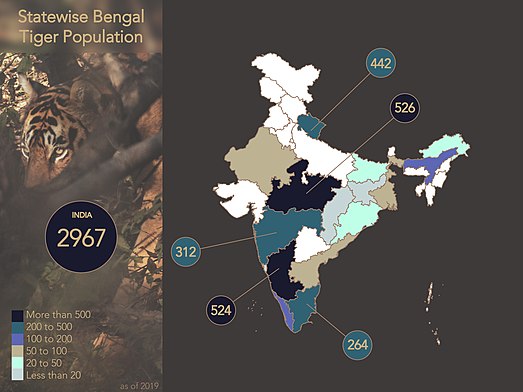Why in News?
Madhya Pradesh High Court has issued NTCA and Central Government a notice regarding the death of 36 tigers this year in a period of 10 months.
Tiger: Importance in the ecosystem
- One of the prime predators on which the whole ecosystem depends; by ensuring the protection of tigers, the balance of the ecosystem is also ensured.
- An umbrella species whose conservation eventually ensures conservation of many other species such as the ungulates, pollinators and other small animals.

Image- Bengal Tiger Panthera Tigris Tigris (Ranthambore National Park, Rajasthan)
Note- There are various subspecies of Tiger e.g Bengal Tiger, Indo Chinese Tiger, Siberian Tiger etc (Tiger = Panthera Tigris- one specie only). The subspecie found in India is known as Bengal Tiger (Panthera Tigris Tigris)
Steps taken by the Indian Government
Financial Steps
- Financial support provided via various Centrally Sponsored Schemes. Eg. Project Tiger and Integrated Wildlife Development Habitat.
The Government of India has taken a pioneering initiative for conserving its national animal, the tiger, by launching the “Project Tiger” in 1973. From 9 tiger reserves since its formative years, the Project Tiger coverage has increased to 52 at present, spread out in 18 of our tiger range states. This amounts to around 2.23% of the geographical area of our country.
Project Tiger is an ongoing Centrally Sponsored Scheme of the Ministry of Environment, Forests and Climate Change providing central assistance to the tiger States for tiger conservation in designated tiger reserves.
Legal Steps
- Amendments made to Wildlife Protection Act, 1972.
- Enabled formation of National Tiger Conservation Authority and Tiger and other Endangered Species Conservation Board (WCCB).
- Enhancement of punishment in cases of an offense relating to a tiger reserve or its core area.
The Wild Life (Protection) Amendment Act, 2006 (No. 39 of 2006) has come into force on 4 September 2006. The Act provides for creating the National Tiger Conservation Authority and the Tiger and Other Endangered Species Crime Control Bureau (Wildlife Crime Control Bureau).
The National Tiger Conservation Authority (NTCA) is a statutory body under the Ministry of Environment, Forests and Climate Change constituted under enabling provisions of the Wildlife (Protection) Act, 1972, as amended in 2006, for strengthening tiger conservation, as per powers and functions assigned to it under the said Act.
Logo of NTCA
Administrative Steps
- Strengthening of anti poaching activities, including special strategy for monsoon patrolling.
- State-level Steering Committees under the Chairmanship of Chief Ministers and establishment of Tiger Conservation Foundation.
- Creation of Special Tiger Protection Force (STPF).
- Tiger Task Force for better implementation of Project Tiger.

Image– Tiger Pugmarks, Sunderbans – Pugmarks are used in counting Tigers under Project Tiger. Nowadays cameras are increasingly being used too.

Image- Tiger Population in India, 2019
International Cooperation
- Signed agreements with Bangladesh, China and Bhutan for Tiger Conservation.
- Party to St. Petersburg Declaration on Tiger Conservation.
- Member of Inter governmental organizations like Global Tiger Forum, Global Tiger Initiative, etc.
Image- Global Tiger Range (South Asia, SE Asia and Russia)
Challenges
Way Forward
Future of Tiger Conservation is bright when we integrate the local communities and address the problem of climate change along with it. Ecological Balance is of utmost importance and hence initiatives and programs undertaken need to be efficiently implemented for the safety and survival of the Ecosystem as a whole.
Best Site for Topic-Wise UPSC Prelims & Mains Preparation